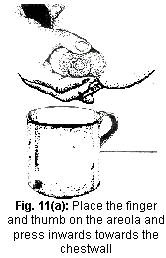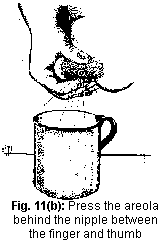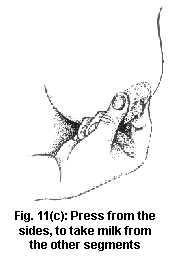Hand expression of breast milk
There are many ways of expressing milk from breast. Breast pumps are very commonly used these days. However in my experience, working as a breast feeding counselor, I found most, if not all, pump devices to be very difficult for mothers to use. This was especially so because it caused a lot of discomfort and pain.
The mothers whom I have taught hand expression technique have all told me that it is virtually pain-free and more effective than mechanical pumps. None of them went back to using mechanical devices.
The structure of the breast
I will discuss the structure of the breast that is important from the point of view of hand expression technique. I will be referring to the diagram below during the discussion.

For the sake of discussion I will divide the breast in to 3 parts.
- The first part, the nipple, is the outlet for the milk produced within the breast. At the tip of the nipple are the openings of the milk ducts through which the milk leaves the breast.
- The second part is the areola. This is the darker pigmented (coloured) area of the breast just around the nipple. Beneath this part of the breast are the lactiferous sinuses, which are the collecting areas, where the milk is stored after production. Also very important to note here is that the skin of the areola is relatively pain insensitive (because it has very little pain receptors).
- The third part is the rest of the breast tissue. This is the largest part of the breast. Under the relatively less pigmented skin of this part of the breast are the many glands that produce the breast milk. The glands are supported by fat and connective tissue that make up the bulk of the breast itself. Note in the diagram above the detail of the milk secreting glands (shown enlarged, inset). There is a layer of muscle (very thin) around the milk secreting cells. These muscles contract in response to the hormone Oxytocin to squeeze the glands to push the milk into the lactiferous sinuses via the ducts.
Preparing to hand express breast milk
How to stimulate Oxytocin production
Oxytocin is a hormone produced by the brain that helps “let down” the milk. As described above, it helps contract the muscle layer around the milk producing glands to push the milk into the lactiferous sinuses. Self confidence and comfort for the mother are essential to effective hand expression of milk. Lack of these causes the brain to decrease the production of the essential hormones.
There are many ways in which Oxytocin production can be increased just before starting hand expression.
- Close contact with the baby like cuddling can increase production of Oxytocin.
- Massaging the breast and the nipple increases Oxytocin production. Massaging the breast gently towards the nipple (not squeezing) is very effective. Another techniques described is “combing” the breast gently towards the nipple using the tips of the fingers or a non-sharp comb.
- Back massage over the back of the chest on either side of the spine is also an effective way of increasing Oxytocin production.
- But perhaps the most effective way to increase Oxytocin production is to allow the baby to suckle on the other breast. Many mothers have themselves noted milk flowing from one breast when baby is feeding on the other. This demonstrates the strength of the Oxytocin effect.
How to hand express breast milk
- Sit or stand comfortably with the bowl or cup placed in a position that will help catch the milk.
- Use right hand for left breast and vice versa.
- Place the thumb on the areola above the nipple and the index finger on the areola below the nipple as shown in the diagram (figure 11.a) below. The pulp of the finger and thumb will be in contact with the skin of the areola, not the nipple or the rest of the breast. This is very important.

- Holding the fingers in the position described above, push the fingers into the breast towards the chest wall. When this is done, the areola will be held between the thumb and the index finger (the nipple will no longer be between the fingers).
- Now squeeze the areola between the thumbs and the index finger (Figure 11.b). The lactiferous sinuses underneath the areola will feel like firm “rope” like structures. When squeezed the milk in them will be pushed towards the tip of the nipple. Please note that the areola is relatively pain insensitive and so this should not cause pain. If, however, the nipple or the breast outside the areola was squeezed it would be painful.

- After squeezing, release the areola gently, making sure not to lift the fingers off the skin.
- Leaving the fingers on the areola, allow the breast to return to its normal shape. This will allow the lactiferous sinuses to re-fill with more milk. The reason why the fingers are not lifted off the skin is to minimize “rubbing” action on the nipple and areola.
- Now repeat steps 4 to 7. Note that the first couple of squeezes may not get the milk to flow out. Keep repeating the steps 4 to 7 and milk will begin to flow (maybe even squirt in jets).
- The expressing should be done all around the areola not just with finger above and below nipple. It is important to rotate the fingers all around to ensure all segments of the breast are expressed.

What not to do during hand expression
If you feel pain during hand expression, it is most likely because of incorrect technique. Check and make sure that you are not squeezing the nipple or skin outside of the areola.
Because the nipple is not pressed during hand expression, this method can be used in mothers who are unable to breastfeed because of cracked nipples.
The diagrams are from training manuals produced by BPNI (Breastfeeding Promotion Network of India).
